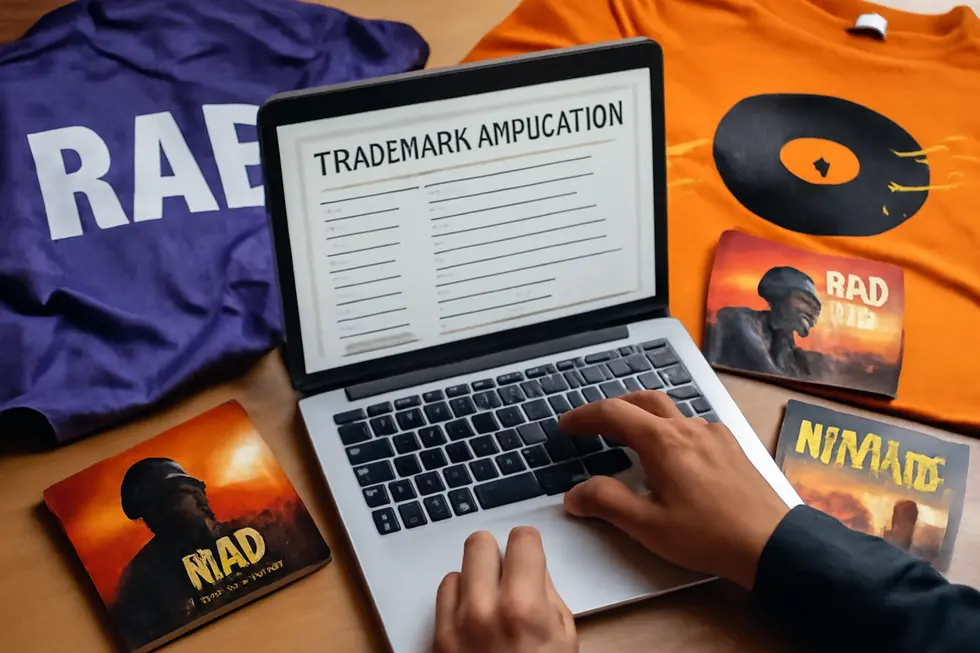Introduction
The power of a rap name extends far beyond mere recognition—it is a critical asset that defines your brand identity and commercial presence in the music industry. Securing exclusive rights to your rap name through trademark registration safeguards your creative efforts from unauthorized use and counterfeit merchandise. For business owners in the entertainment field, understanding the trademark process is essential to reinforce your brand’s market position. This comprehensive guide breaks down the trademark journey into four vital stages: conducting a thorough name search to avoid conflicts, filing the correct application with the United States Patent and Trademark Office (USPTO) including proper class selection, navigating the USPTO’s review process with timely responses, and maintaining plus enforcing your trademark post-registration. Each chapter offers in-depth insights that build a cohesive understanding, empowering you to protect and capitalize on your rap persona effectively.
Tables of Contents
Chapter 1: How to Trademark Your Rap Name: Conducting a Comprehensive Name Search and Clearance
- Mastering USPTO Database Searches to Secure Your Rap Name Trademark
- Securing Domain Names to Strengthen Your Rap Name’s Trademark Clearance and Online Presence
- Ensuring Brand Uniformity: Comprehensive Rap Name Search Plus Social Media Handle Verification
- Ensuring Unique Branding: In-Depth Common Law and Industry Usage Searches for Your Rap Name
- Mastering Legal Clearance and Filing Steps to Secure Your Rap Name Trademark
Chapter 2: How to Trademark Your Rap Name: Filing Your Application with the USPTO and Selecting the Correct Trademark Class
- Mastering the USPTO Application Path: Filing Your Rap Name and Choosing the Right Trademark Class for Maximum Protection
- Mastering Trademark Search and Classification to Perfectly File Your Rap Name with the USPTO
- Mastering Trademark Classes: Protecting Your Rap Name Across Music and Merchandise
- Mastering the Application Process: Preparing and Filing Your Rap Name Trademark with Precision
- Protecting and Enforcing Your Rap Name Trademark After USPTO Filing
Chapter 3: How to Trademark Your Rap Name: Navigating the USPTO Review Process and Responding to Office Actions
- Mastering the Essential Trademark Search to Secure Your Rap Name’s Unique Identity
- Mastering the Trademark Application: Essential Steps to Secure Your Rap Name with the USPTO
- Decoding the USPTO Examination and Office Actions for Your Rap Name Trademark
- Mastering Office Action Responses: Key Strategies to Overcome USPTO Obstacles When Trademarking Your Rap Name
- Securing Your Rap Name: Understanding Publication, Opposition, and Final Registration Steps
Chapter 4: How to Trademark Your Rap Name: Maintaining and Enforcing Your Registered Trademark for Brand Protection
- Sustaining Your Rap Name’s Trademark: Essential Steps for Active Use and Timely Maintenance
- Protecting Your Rap Name: Effective Enforcement Strategies Against Trademark Infringement
- Navigating the Trademark Registration Journey: Essential Legal Steps for Rap Artists Securing Their Brand
- Vigilant Online and Marketplace Surveillance to Secure Your Rap Name Trademark
- Expanding Brand Security: Integrating Trademark Registration with Complementary IP Strategies for Your Rap Name
Chapter 1: How to Trademark Your Rap Name: Conducting a Comprehensive Name Search and Clearance

1. Mastering USPTO Database Searches to Secure Your Rap Name Trademark
The first essential step in trademarking your rap name is conducting a thorough search using the United States Patent and Trademark Office (USPTO) database. This ensures your chosen name is unique and not already registered or confusingly similar to existing trademarks, particularly within Class 41 for entertainment services or Class 9 for recorded music. Access the USPTO’s Trademark Electronic Search System (TESS) to examine exact and phonetic variations of your name. Carefully review results for active registrations or pending applications in related classes that could block your trademark. Evaluating these helps you avoid costly legal conflicts later. Given how nuanced trademark law can be, consulting a trademark attorney is advisable to interpret findings and assess risks accurately. Once confident your rap name is clear, you can proceed with filing through the USPTO’s electronic application system. Maintaining vigilance post-registration is crucial to defend your brand from infringement. For deeper insight, explore expert guidance on trademark protection tailored for business names and logos.
2. Securing Domain Names to Strengthen Your Rap Name’s Trademark Clearance and Online Presence
After ensuring your rap name is clear of existing trademarks through the USPTO search, securing matching domain names is vital to solidify your brand’s online identity. Begin by checking domain availability using popular registrars, prioritizing the “.com” extension for its wide recognition and professionalism. If your preferred domain is taken, consider alternatives like “.net”, “.co”, or creative modifiers such as adding “music” or “official” to your name. This strategy helps preserve brand consistency and prevents confusion among fans.
Simultaneously, claim social media handles that echo your rap name on key platforms to maintain a unified presence. Consistency across digital spaces complements your trademark rights by strengthening your brand recognition and making unauthorized use easier to spot.
Trademark registration empowers you to legally protect your name, but controlling related domain and social identities enhances your market reach and deters infringement. Leveraging experienced legal guidance can help navigate this process efficiently, maximizing both protection and visibility. Learn more about how trademark protection integrates with business naming strategies at [trademark2go.com/company-name-copyright-registration/].
3. Ensuring Brand Uniformity: Comprehensive Rap Name Search Plus Social Media Handle Verification
Before trademarking your rap name, it’s crucial to conduct a thorough search to avoid conflicts with existing marks. Start by using the USPTO’s Trademark Electronic Search System (TESS) to identify registered or pending trademarks that could interfere with your name in entertainment-related categories. Equally important is verifying that your rap name is available across social media platforms like Instagram, Twitter, Facebook, YouTube, and TikTok. Securing consistent handles prevents brand confusion and helps establish a recognizable identity. Social media presence often complements trademark protection by enabling you to detect and challenge impersonators. Analyzing search results carefully helps assess risks of confusion or infringement, and consulting a trademark attorney can provide valuable legal insight. Ultimately, this combined process safeguards your brand, reinforcing your rap identity both legally and socially. For more on trademark protection in entertainment, visit trademark2go.com/trademark-protection-business-name-logo/
4. Ensuring Unique Branding: In-Depth Common Law and Industry Usage Searches for Your Rap Name
Before filing a trademark application for your rap name, conducting an extensive search beyond the USPTO’s database is essential. This involves probing common law usage to uncover unregistered but actively used names across digital platforms like YouTube, Spotify, and social media, where many emerging artists build their presence. Additionally, industry-specific searches in music rights organizations such as ASCAP and BMI reveal names registered for performance rights. Local music scenes and merchandising channels also host potential conflicts, as trademark rights can arise from actual use in commerce. Analyzing these sources helps identify any confusingly similar names that risk legal challenges. Since interpreting these findings requires expert knowledge of trademark law nuances, consulting an intellectual property attorney can clarify risks and optimize your clearance strategy. Thorough clearance minimizes costly disputes and supports exclusive nationwide rights once you file with the USPTO under the correct classes, such as entertainment services or apparel. For deeper context on the importance of common law rights in trademark protection, see this resource on common law trademark rights.
5. Mastering Legal Clearance and Filing Steps to Secure Your Rap Name Trademark
Trademarking your rap name involves more than just a simple search; it requires a thorough legal clearance and carefully executed filing procedures to secure exclusive rights. Begin by conducting a broad search using the USPTO’s Trademark Electronic Search System (TESS) to detect any direct or confusingly similar trademarks, especially within entertainment classes. Expand your search to social media, domain registrations, and streaming platforms to catch unregistered but common law uses that might pose conflicts. To reduce legal risks, enlist a trademark attorney for a detailed clearance search addressing state registrations and common law usage. Next, identify the correct trademark class—often Class 41 for entertainment services—to define your protection scope. When preparing your USPTO application via TEAS, provide your rap name, a precise description of goods and services, and an example of actual use, such as album artwork or merchandise labeling. USPTO examiners will review the application and may issue office actions requiring your response. If cleared, your mark publishes for opposition, and after this period with no disputes, you receive official registration. This legal shield empowers you to enforce your rights against imitators and counterfeiters effectively. For deeper insights on protecting entertainment identities, consult resources on trademark protection for business names and logos.
Chapter 2: How to Trademark Your Rap Name: Filing Your Application with the USPTO and Selecting the Correct Trademark Class

1. Mastering the USPTO Application Path: Filing Your Rap Name and Choosing the Right Trademark Class for Maximum Protection
Trademarking your rap name begins with filing an application through the USPTO’s Trademark Electronic Application System (TEAS). A crucial early step is correctly selecting the trademark class, as this determines the legal scope of protection. For rappers, Class 41 covers entertainment services like live performances and music production, while Class 9 includes recorded or downloadable music files. Prior to filing, conducting a thorough trademark search helps avoid conflicts with existing marks in these classes. The application requires precise details: your rap name, the owner’s information, the goods or services associated with your mark, and a filing basis indicating current or intended commercial use. Paying the required USPTO filing fee completes the initial submission. Afterwards, USPTO examiners review the application, potentially issuing office actions that need timely responses. If approved, your trademark enters a public notice period, allowing for oppositions before final registration. Selecting the right class and filing carefully ensures your rap name receives the strongest legal shield possible. For guidance on trademark protection strategies relevant to brand identity, consider exploring trademark protection for business names and logos.
2. Mastering Trademark Search and Classification to Perfectly File Your Rap Name with the USPTO
Conducting a thorough trademark search is pivotal before filing your rap name with the USPTO. Utilize the Trademark Electronic Search System (TESS) to uncover existing or pending trademarks that resemble your chosen name. This includes exploring variations and phonetic similarities to avoid potential conflicts that could lead to application refusal. Complement your search by monitoring the Trademark Official Gazette (TMOG), ensuring awareness of newly published marks. When filing, create an account on USPTO.gov and submit your application via the Trademark Electronic Application System (TEAS). Your submission must include the rap name, owner details, a specimen showcasing your mark’s commercial use—like album art or merchandise—and the appropriate filing fee. Equally crucial is selecting the correct trademark class(es) based on your music and merchandise use, commonly Class 41 for entertainment services, Class 9 for downloadable music, and Class 25 for branded clothing. Choosing relevant classes ensures precise legal protection tailored to your brand’s commercial activities. For comprehensive guidance on trademark rights in business, explore resources on trademark protection. This precise preparation lays the foundation for a smooth, successful registration process.
3. Mastering Trademark Classes: Protecting Your Rap Name Across Music and Merchandise
When trademarking your rap name, selecting the correct trademark class with the USPTO is essential to secure the right legal protection. Trademark classes categorize your name’s commercial use, ensuring it covers the specific services or goods you offer. Typically, Class 41 serves as the cornerstone for entertainers, covering live performances, music production, and promotion, making it the primary classification for rap artists. However, if your brand extends beyond music—such as selling clothing or accessories—registering under Class 25 for apparel is necessary. Additionally, digital products like downloadable music fall under Class 9. Filing across multiple classes is common and vital to comprehensively protect your brand identity. Accurate classification not only reduces risks of USPTO rejection but also strengthens your rights against infringement. Utilize USPTO resources, such as the Trademark Manual of Examining Procedure, to confirm your classifications align with your commercial use. This strategic approach gives your rap name robust protection across all artistic and merchandising platforms, empowering your brand’s growth and defense. For more insight into protecting brand identity through trademarks, review this guide on trademark protection for business names and logos.
4. Mastering the Application Process: Preparing and Filing Your Rap Name Trademark with Precision
Securing your rap name as a trademark requires a strategic and precise application process. Begin by thoroughly researching your chosen name using the USPTO’s Trademark Electronic Search System (TESS) to avoid conflicts. Selecting the proper trademark class is essential—most rap names fall under entertainment services, music production, or merchandise. Accurate classification ensures the scope of your legal protection aligns with your brand’s use. When preparing your application, detail your rap name exactly as you want it registered, specify associated goods or services, and include a specimen showing real-world usage, like album art or merch. Submitting through the USPTO’s online system demands attention to accuracy to prevent delays. Pay the required fees and retain your confirmation receipt for reference. After filing, actively monitor your application’s progress to promptly address any USPTO inquiries or oppositions. Applying early—ideally before public promotion—strengthens your claim. For a clearer understanding of trademark protection essentials, explore trademark protection business name and logo guidance to safeguard your identity effectively.
5. Protecting and Enforcing Your Rap Name Trademark After USPTO Filing
After filing your rap name trademark application with the USPTO, active monitoring and enforcement become essential to preserving your rights. Trademark protection is limited to the chosen classes—usually entertainment services (Class 41) or merchandise like clothing (Class 25)—making correct classification critical. Once registered, vigilantly watch for unauthorized or confusingly similar uses on social media, merchandise, and other marketplaces, utilizing your exclusive rights to combat infringement. Enforcement may include submitting infringement claims to platforms such as Instagram or YouTube and collaborating with customs to block counterfeit goods. Legal disputes can arise, especially in the competitive entertainment industry; having knowledgeable trademark counsel can help you navigate oppositions or challenges efficiently. Additionally, maintaining your registration through timely renewals is vital to keep your trademark active. This ongoing diligence safeguards your rap name’s commercial value and brand identity in the music scene. For more on rights enforcement after filing, see detailed strategies in trademark protection for personal brands.
Chapter 3: How to Trademark Your Rap Name: Navigating the USPTO Review Process and Responding to Office Actions

1. Mastering the Essential Trademark Search to Secure Your Rap Name’s Unique Identity
Before formally filing your trademark application for your rap name, conducting a meticulous and comprehensive trademark search is indispensable. Begin by exploring the USPTO’s Trademark Electronic Search System (TESS) to detect any exact or closely similar registered marks that might block your registration. However, since trademark rights also arise from actual use, expanding your search beyond the USPTO is crucial. Investigate common law trademarks, domain names, social media platforms, and business registries to uncover unregistered but potentially conflicting uses. Assess the results with an eye on how the appearance, sound, meaning, and overall commercial impression of existing marks compare to your rap name, especially considering public confusion risks in the music industry. Given the complexity and importance of this step, consulting a trademark attorney experienced in entertainment law elevates your ability to accurately gauge risks and navigate potential USPTO objections or oppositions effectively. This foundational search not only minimizes rejections but also strengthens your brand protection strategy as you proceed in the USPTO review process. For more insights on trademark rights emerging from unregistered uses, see detailed guidance on common law trademark rights.
2. Mastering the Trademark Application: Essential Steps to Secure Your Rap Name with the USPTO
Filing your trademark application for a rap name begins with thorough preparation to ensure a smooth USPTO review process. After verifying your name’s availability through a comprehensive search, you must choose the trademark format, typically either a standard character mark or a stylized/design mark. Identifying the correct classification—often related to entertainment, music recordings, or merchandise—is vital for protecting the right commercial use. Your application must include your rap name, owner details, and a specimen showing the name in commerce, such as album artwork or promotional materials. When you submit via the USPTO’s Trademark Electronic Application System (TEAS), select the appropriate filing basis, either “use in commerce” or “intent to use,” and pay the relevant fee. Following submission, an examining attorney reviews your application for legal compliance and conflicts, potentially issuing office actions to request clarifications or raise refusals. Timely and accurate responses to these office actions are critical to advancing your trademark toward registration. This careful approach establishes exclusive rights over your rap name and is a key step in safeguarding your brand identity. For further insights, you can explore expert guidance on trademark protections related to business names and logos.
3. Decoding the USPTO Examination and Office Actions for Your Rap Name Trademark
When trademarking your rap name, understanding the USPTO review process is key to securing your brand’s exclusive rights. After filing through the Trademark Electronic Application System (TEAS), your application undergoes examination by an attorney who assesses potential conflicts and compliance with trademark law. If issues arise—such as name similarity or descriptiveness—the USPTO issues an Office Action detailing refusals or objections. You have six months to reply with legal arguments, clarifications, or amendments to resolve these concerns. Successful navigation of this stage is crucial to avoid abandonment. Upon overcoming any hurdles, your rap name is published for third-party opposition. Without opposition, your trademark proceeds to registration, granting you enforceable exclusive commercial rights. Mastering this process ensures your rap name stands protected from infringement in the competitive music industry. For a deeper understanding of legal challenges in trademark protection, consider exploring comprehensive resources on trademark law and enforcement.
4. Mastering Office Action Responses: Key Strategies to Overcome USPTO Obstacles When Trademarking Your Rap Name
Responding effectively to a USPTO Office Action is a pivotal step in successfully trademarking your rap name. Each Office Action details specific issues raised by the examining attorney, requiring clear, thorough replies that directly address every concern without leaving gaps. Maintaining a professional tone is crucial; the examiner is your ally in the review process, not an adversary. Strengthening your responses with relevant legal precedents, USPTO guidelines, and concrete evidence—such as examples of your rap name’s use—builds a persuasive case. For descriptiveness refusals, demonstrating that your rap name is distinctive or has acquired secondary meaning can turn the tide in your favor. Timeliness is equally important: submitting your response before the deadline prevents abandonment and allows time to refine your position. Given the complexities, consulting an experienced trademark attorney familiar with entertainment trademarks can improve your application’s success. This measured approach ensures your rap name moves past hurdles and closer to official registration. For more about trademark protection for business names and logos, see this detailed resource.
5. Securing Your Rap Name: Understanding Publication, Opposition, and Final Registration Steps
Once your rap name application clears the USPTO’s initial scrutiny and any Office Actions, it moves to a critical public phase—publication in the Official Gazette. This 30-day period invites third parties to review and possibly oppose your trademark if they believe it infringes on their rights. Should opposition arise, it triggers a formal legal process before the Trademark Trial and Appeal Board (TTAB). This procedure leans heavily on written evidence and arguments rather than in-person hearings, and it can extend for years, requiring careful navigation to defend your claim. If no opposition is filed, or if you successfully overcome one, the USPTO issues a final registration that grants federal protection to your rap name. This registration confers exclusive nationwide rights, allowing you to use the ® symbol and enforce your brand against unauthorized use. Given the complexity of these final steps, especially TTAB proceedings, engaging a trademark attorney familiar with entertainment trademarks can be invaluable in securing and protecting your rap identity. For a deeper look at federal trademark protections, see this detailed guide on trademark protection for business names and logos.
Chapter 4: How to Trademark Your Rap Name: Maintaining and Enforcing Your Registered Trademark for Brand Protection

1. Sustaining Your Rap Name’s Trademark: Essential Steps for Active Use and Timely Maintenance
Registering your rap name with the USPTO is only the beginning of protecting your brand. To maintain this protection, continuous and active commercial use of your trademark is crucial. This means consistently featuring your rap name on music releases, merchandise, performances, and promotional materials, demonstrating your ongoing claim to the mark. Failure to use the trademark can lead to cancellation, so keeping your brand visible and linked to your activities matter deeply.
Additionally, timely filings of maintenance documents at key intervals—between the 5th and 6th year, 9th and 10th year, and every decade thereafter—are mandatory to keep the registration in force. These filings prove your continued use and legally affirm your rights. If you miss these deadlines or neglect active use, your trademark could be vulnerable to abandonment.
Legal enforcement is another pillar of protection; with a registered trademark, you can challenge infringers, especially on social media and online platforms. Given the complexities, consulting with a trademark attorney familiar with entertainment brand protection can simplify this process and help safeguard your rap name effectively.
For more insight on maintaining exclusive rights, see this detailed resource on trademark protections for businesses.
2. Protecting Your Rap Name: Effective Enforcement Strategies Against Trademark Infringement
Once your rap name is federally registered, you gain exclusive rights to its commercial use. Enforcing these rights begins with consistent monitoring of digital platforms and marketplaces to detect unauthorized usage or confusingly similar names. Social media sites like Instagram, YouTube, and Twitch allow you to submit infringement claims using your trademark registration, enabling removal of illegal accounts or content. If these actions fail, sending cease-and-desist letters becomes necessary to formally demand the infringing party stop using your mark. Persistent violations may require pursuing legal remedies, including filing lawsuits to halt infringement and potentially recover damages. Additionally, you can enlist U.S. Customs to intercept counterfeit merchandise bearing your trademark at the border. Because enforcement can be complex and costly, seeking counsel from an intellectual property attorney specializing in entertainment law is invaluable. This proactive approach ensures your rap name remains a powerful, legally protected brand identity resistant to unauthorized exploitation. For deeper insights, see our guide on trademark protection for business names and logos.
3. Navigating the Trademark Registration Journey: Essential Legal Steps for Rap Artists Securing Their Brand
Trademarking your rap name requires a precise legal process through the United States Patent and Trademark Office (USPTO). Start with a thorough search to confirm your name isn’t already registered or confusingly similar to others, avoiding application rejection. Identifying the correct trademark class is crucial, usually covering entertainment, music, or merchandise like apparel. Your application must include your name, what goods or services it represents, and proof of actual use, such as album covers or branded merchandise. After filing, you might receive office actions or oppositions, necessitating timely and careful responses to keep the process on track. Once registered, actively protect your trademark by monitoring unauthorized uses and counterfeit merchandise, essential for maintaining your exclusive rights and digital presence. Given the intricacies of trademark law and potential disputes in the entertainment industry, consulting a trademark attorney with experience in music branding maximizes your legal protection. For more on protecting your brand identity legally, explore guidance on trademark protection for business names and logos.
4. Vigilant Online and Marketplace Surveillance to Secure Your Rap Name Trademark
Maintaining the strength of your registered rap name trademark demands continuous vigilance across online platforms and marketplaces. Monitoring social media channels such as Instagram, YouTube, Twitter, and Twitch helps identify unauthorized uses or imitations of your name early. Many platforms provide mechanisms to report trademark infringements, enabling swift removal of counterfeit accounts or content. Similarly, regular scans of e-commerce websites can uncover unauthorized merchandise that exploits your brand without permission. Leveraging specialized brand monitoring tools can automate this surveillance, alerting you to potential infringements before they escalate. Beyond digital spaces, notifying customs authorities to intercept counterfeit imports serves as a crucial defense against fake goods bearing your trademark. Staying updated via the USPTO’s Trademark Official Gazette allows you to spot and oppose potentially conflicting trademark applications. Enforcing your rights promptly, ideally with expert legal counsel familiar with music industry trademarks, preserves your brand’s exclusivity and deters unauthorized usage, ensuring your rap name remains a protected asset. For more on protecting your business name and logo, see this resource on trademark protection business name logo.
5. Expanding Brand Security: Integrating Trademark Registration with Complementary IP Strategies for Your Rap Name
Trademark registration offers a foundational shield for your rap name, but robust brand protection demands a multi-layered approach. Alongside securing your trademark through the USPTO, registering copyrights for your music and lyrics fortifies your creative assets against unauthorized use. Equally important is protecting visual identifiers—such as your logo or stage persona—by registering them as trademarks, enhancing your brand’s visual recognition and legal safeguard.
Owning domain names and social media handles that mirror your rap name further consolidates your online presence, preventing others from capitalizing on your identity. Licensing agreements allow you to control brand usage, especially for merchandise or endorsements, ensuring consistent representation and revenue streams. After registration, vigilant monitoring and prompt enforcement, including cease-and-desist actions, maintain your trademark’s exclusivity and deter infringement.
Embracing these intellectual property strategies in harmony builds a strong, enforceable framework with lasting brand resilience. For deeper insights into protecting your brand elements, consider exploring trademark protections that cover business names and logos.
Final thoughts
Trademarking your rap name transforms it from a creative signature into a legally protected brand asset that can significantly enhance your business potential and market control. By conducting a comprehensive name search, correctly filing your trademark application under appropriate classes, proactively navigating USPTO reviews, and vigilantly maintaining and enforcing your rights, you secure a foundation for long-term success in the competitive music industry. Legal protection equips business owners with the tools to prevent unauthorized exploitation and counterfeit issues, safeguarding not only income but also reputation. Embracing this structured approach ensures your rap name remains exclusively yours, empowering your brand to grow with confidence.
Your IP is the foundation of your success – let’s protect it together before it’s too late. We can’t wait to help you turn your ideas into legally secured assets.
About us
undefined


